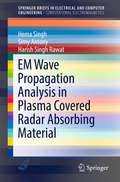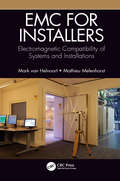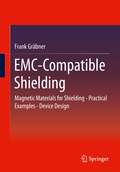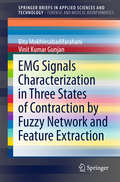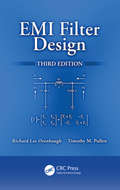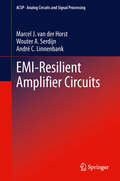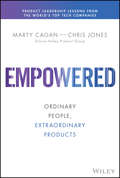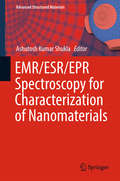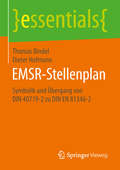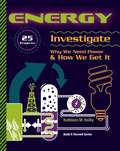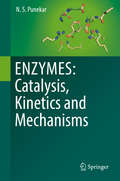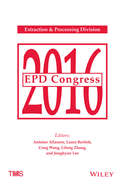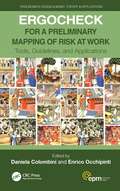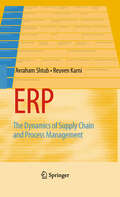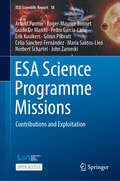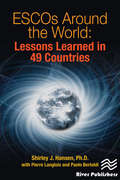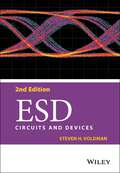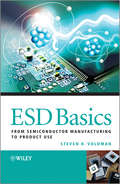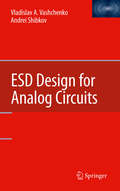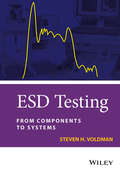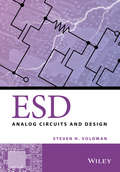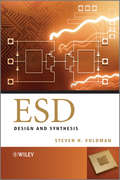- Table View
- List View
EM Wave Propagation Analysis in Plasma Covered Radar Absorbing Material
by Hema Singh Simy Antony Harish Singh RawatThis book focuses on EM propagation characteristics within multilayered plasma-dielectric-metallic media. The method used for analysis is impedance transformation method. Plasma covered radar absorbing material is approximated as a multi-layered dielectric medium. The plasma is considered to be bounded homogeneous/inhomogeneous medium. The reflection coefficient and hence return loss is analytically derived. The role of plasma parameters, such as electron density, collision frequency, plasma thickness, and plasma density profile in the absorption behavior of multi-layered plasma-RAM structure is described. This book provides a clearer picture of EM propagation within plasma. The reader will get an insight of plasma parameters that play significant role in deciding the absorption characteristics of plasma covered surfaces.
EMC for Installers: Electromagnetic Compatibility of Systems and Installations
by Mark Van Helvoort Mathieu MelenhorstThe integration of electronics in large systems and installations steadily increases, consider for example the emergence of the Industrial Internet of Things. Power consumption decreases while the operating speed increases making equipment potentially more vulnerable for interference. The responsibility of the installer is shifting towards that of the system integrator, requiring more in-depth knowledge to achieve and maintain EMC during the technical and economical lifespan of the system or installation and the distinction between both diminishes. EMC for Installers: Electromagnetic Compatibility of Systems and Installations combines an integral risk based approached to EMC design and management with robust technical measures. Written by two experts, who both started nearly three decades ago in EMC, it provides guidance to those new in the field and servers as reference to those with experience. The book starts with the basic concept of EMC and evolves gradually towards more difficult topics. Particular attention is given to grounding concepts and the protection of cabling and wiring. This book puts a strong focus on passive means that are widely available for each installer: cable conduits used for cable routing can be exploited for significant improvement of the EMC-behavior of the system or installation. In addition, it will be explained how to use standard metallic enclosures to enhance the EMC-performance. For most demanding situations shielded rooms and shielding cabinets are explained. This book describes pre-compliance and full-compliance testing tailored to large systems. Templates and checklists are provided for both risk and management and test management. Electromagnetic compatibility explained as simple as possible, without over-simplifying. Practical approach, with hands-on demonstrations based on an example installation. Learn how to exploit cable conduits, used for cable routing anyway, to improve the EMC performance of an installation. Learn how to exploit standard metallic enclosures to improve EMC in systems. Design of power distribution networks to minimize disturbing fields. Toolbox and templates for managing and sustaining EMC over a long lifetime.
EMC-Compatible Shielding: Magnetic Materials for Shielding - Practical Examples - Device Design
by Frank GräbnerThe 3rd edition was extended by the chapter "Novel Future Ferrites - Hexagonal Ferrites". The reader is thus given the basics of the various shielding effects in a compressed form. This book is addressed to engineers, scientists, students, researchers and specialists from the practice. Shielding for ensuring EMC in high-frequency and radar technology has been developing with ever increasing dynamics since about 1960. The understanding of the interaction of a magnetic material and the resulting phenomenon of shielding is illustrated by simple examples and practical applications.
EMG Signals Characterization in Three States of Contraction by Fuzzy Network and Feature Extraction
by Bita Mokhlesabadifarahani Vinit Kumar GunjanNeuro-muscular and musculoskeletal disorders and injuries highly affect the life style and the motion abilities of an individual. This brief highlights a systematic method for detection of the level of muscle power declining in musculoskeletal and Neuro-muscular disorders. The neuro-fuzzy system is trained with 70 percent of the recorded Electromyography (EMG) cut off window and then used for classification and modeling purposes. The neuro-fuzzy classifier is validated in comparison to some other well-known classifiers in classification of the recorded EMG signals with the three states of contractions corresponding to the extracted features. Different structures of the neuro-fuzzy classifier are also comparatively analyzed to find the optimum structure of the classifier used.
EMI Filter Design (Electrical Engineering And Electronics Ser. #Vol. 95)
by Richard Lee Ozenbaugh Timothy M. PullenWith today’s electrical and electronics systems requiring increased levels of performance and reliability, the design of robust EMI filters plays a critical role in EMC compliance. Using a mix of practical methods and theoretical analysis, EMI Filter Design, Third Edition presents both a hands-on and academic approach to the design of EMI filters and the selection of components values. The design approaches covered include matrix methods using table data and the use of Fourier analysis, Laplace transforms, and transfer function realization of LC structures. This edition has been fully revised and updated with additional topics and more streamlined content. New to the Third Edition Analysis techniques necessary for passive filter realization Matrix method and transfer function analysis approaches for LC filter structure design A more hands-on look at EMI filters and the overall design process Through this bestselling book’s proven design methodology and practical application of formal techniques, readers learn how to develop simple filter solutions. The authors examine the causes of common- and differential-mode noise and methods of elimination, the source and load impedances for various types of input power interfaces, and the load impedance aspect of EMI filter design. After covering EMI filter structures, topologies, and components, they provide insight into the sizing of components and protection from voltage transients, discuss issues that compromise filter performance, and present a goal for a filter design objective. The text also includes a matrix method for filter design, explains the transfer function method of LC structures and their equivalent polynomials, and gives a circuit design example and analysis techniques. The final chapter presents packaging solutions of EMI filters.
EMI-Resilient Amplifier Circuits
by Marcel J. van der Horst André C. Linnenbank Wouter A. SerdijnThis book enables circuit designers to reduce the errors introduced by the fundamental limitations (noise, bandwith, and signal power) and electromagnetic interference (EMI) in negative-feedback amplifiers. The authors describe a systematic design approach for application specific negative-feedback amplifiers, with specified signal-to-error ratio (SER). This approach enables designers to calculate noise, bandwidth, EMI, and the required bias parameters of the transistors used in application specific amplifiers in order to meet the SER requirements.
EMPOWERED: Ordinary People, Extraordinary Products (Silicon Valley Product Group)
by Marty CaganWhat is it about the top tech product companies such as Amazon, Apple, Google, Netflix and Tesla that enables their record of consistent innovation? Most people think it’s because these companies are somehow able to find and attract a level of talent that makes this innovation possible. But the real advantage these companies have is not so much who they hire, but rather how they enable their people to work together to solve hard problems and create extraordinary products. As legendary Silicon Valley coach--and coach to the founders of several of today’s leading tech companies--Bill Campbell said, “Leadership is about recognizing that there's a greatness in everyone, and your job is to create an environment where that greatness can emerge.” The goal of EMPOWERED is to provide you, as a leader of product management, product design, or engineering, with everything you’ll need to create just such an environment. As partners at The Silicon Valley Product Group, Marty Cagan and Chris Jones have long worked to reveal the best practices of the most consistently innovative companies in the world. A natural companion to the bestseller INSPIRED, EMPOWERED tackles head-on the reason why most companies fail to truly leverage the potential of their people to innovate: product leadership. The book covers: what it means to be an empowered product team, and how this is different from the “feature teams” used by most companies to build technology products recruiting and coaching the members of product teams, first to competence, and then to reach their potential creating an inspiring product vision along with an insights-driven product strategy translating that strategy into action by empowering teams with specific objectives—problems to solve—rather than features to build redefining the relationship of the product teams to the rest of the company detailing the changes necessary to effectively and successfully transform your organization to truly empowered product teams EMPOWERED puts decades of lessons learned from the best leaders of the top technology companies in your hand as a guide. It shows you how to become the leader your team and company needs to not only survive but thrive.
EMR/ESR/EPR Spectroscopy for Characterization of Nanomaterials
by Ashutosh Kumar ShuklaThe subject matter of this book is the application of EMR/ESR/EPR spectroscopy for characterization of nanomaterials. Initial chapters deal with nanomaterials and their classification. Characterization of metallic nanoparticles, metal oxide nanoparticles and rare earth impurity doped nanoparticles from the (ESR) spectrum parameters are covered in the chapters that follow. A special feature of the book is EMR/ESR/EPR spectroscopic characterization of nanoparticles which are important due to their bactericidal and anticancerous properties. Strength of continuous wave (CW) is explained with the help of suitable examples. The book focuses on applications and data interpretation avoiding extensive use of mathematics so that it also caters to the need of young scientists in the life science disciplines. The book includes a comparison with other spectroscopic characterization methods so as to give an integrated approach to the reader. It will prove useful to biomedical scientists and engineers, chemists, and materials engineers in student, researcher, and practitioner positions.
EMSR-Stellenplan: Symbolik Und Übergang Von Din 40719-2 Zu Din En 81346-2 (Essentials)
by Dieter Hofmann Thomas BindelThomas Bindel und Dieter Hofmann ordnen EMSR- bzw. PCE-Stellenpläne als wichtige Unterlagen der Projektierung von Automatisierungsanlagen ein. DIN 19227-2 gilt weiterhin, jedoch wurde DIN 40719-2 zurückgezogen und durch DIN EN 81346-2 ersetzt. Da in EMSR-Stellenplänen bereits existierender Anlagen Betriebsmittel nach DIN 40719-2 gekennzeichnet wurden, stehen Anwender vor einer Herausforderung: Sie müssen diese Norm nach wie vor verstehen, für Neuanlagen in EMSR- bzw. PCE-Stellenplänen zur Referenzkennzeichnung jedoch statt DIN 40719-2 die sich eher zögerlich durchsetzende DIN EN 81346-2 anwenden. Die Autoren beleuchten die mit diesem Übergang verbundenen Änderungen und geben so Orientierung zur Nutzung von DIN EN 81346 für das Fachgebiet der Projektierung von Automatisierungsanlagen.Die AutorenProf. Dr.-Ing. Thomas Bindel lehrt Automatisierungstechnik an der Fakultät Elektrotechnik der Hochschule für Technik und Wirtschaft Dresden. Priv.-Doz. Dr.-Ing. Dieter Hofmann lehrte und lehrt Prozessautomatisierung an der TU Dresden sowie an der Staatlichen Studienakademie Bautzen.
ENERGY
by Kathleen M ReillyEnergy is a vital part of our lives. It powers our computer, lights our home, and moves our car. It also costs a lot of money and pollutes our environment. In Energy: 25 Projects Investigate Why We Need Power and How We Get It, kids ages 9-12 learn about the history and science of the world's energy sources, from nonrenewable fossil fuels such as oil and natural gas to renewable sources such as solar and wind power.Sidebars and fun trivia break up the text, making it easily accessible and engaging, while hands-on projects encourage active learning. Requiring little adult supervision and using supplies commonly found in most households, activities range from constructing a battery to recreating an oil spill to see howdifficult cleanup can be.By exploring the advantages and disadvantages of each energy source, kids will gain insight into the future of energy and its impact on our planet.
ENERGY 2040: Aligning Innovation, Economics and Decarbonization
by Deepak Divan Suresh SharmaAccess to energy is essential for our daily lives, economic growth, environment, and sustainability. However, our use of fossil fuels has contributed to global climate change, which poses a significant threat to society and life on this planet. Yet, it has been challenging to reconcile the perceived conflict between economics and climate change, which has created deep divisions in our society. ENERGY 2040: Aligning Innovation, Economics, and Decarbonization provides a holistic and comprehensive analysis of the ongoing energy transition and its underlying causes. It presents a viable path to meet the energy, economic, and climate goals by weaving together science, technology, economics, policy, entrepreneurship, and geopolitics. The book presents a captivating narrative that brings together a range of topics, including new and disruptive technologies with steep learning rates, the challenges of the future power grid, the democratization of energy, and reducing the timeline from science to impact at scale. It also explores the complex role of scientific research, disruptive deep tech, entrepreneurship, and policy in accelerating this energy transformation. This book is a must-read for anyone interested in understanding the future of energy. Whether you're a scientist, energy-industry practitioner, policymaker, investor, student, or concerned citizen, this book offers critical insights into the complex and evolving world of energy, innovation, decarbonization, and climate change.
ENZYMES: Catalysis, Kinetics and Mechanisms
by N. S. PunekarThis enzymology textbook for graduate and advanced undergraduate students covers the syllabi of most universities where this subject is regularly taught. It focuses on the synchrony between the two broad mechanistic facets of enzymology: the chemical and the kinetic, and also highlights the synergy between enzyme structure and mechanism. Designed for self-study, it explains how to plan enzyme experiments and subsequently analyze the data collected. The book is divided into five major sections: 1] Introduction to enzymes, 2] Practical aspects, 3] Kinetic Mechanisms, 4] Chemical Mechanisms, and 5] Enzymology Frontiers. Individual concepts are treated as stand-alone chapters; readers can explore any single concept with minimal cross-referencing to the rest of the book. Further, complex approaches requiring specialized techniques and involved experimentation (beyond the reach of an average laboratory) are covered in theory with suitable references to guide readers. The book provides students, researchers and academics in the broad area of biology with a sound theoretical and practical knowledge of enzymes. It also caters to those who do not have a practicing enzymologist to teach them the subject.
EPA Environmental Engineering Sourcebook
by J. Russell BouldingThe U.S. Environmental Protection Agency (U.S. EPA) publishes several series of documents that provide up-to-date information about environmental site assessment and remediation. The EPA Environmental Engineering Sourcebook includes papers and bulletins that focus on remediation of soil and groundwater, making them available in a convenient form.This book compiles thirty-five documents- written by recognized leaders - on major methods and promising new techniques for hazardous waste treatment and site remediation. Each chapter evaluates the type of contaminant and site characteristics needed to select a technology for use at hazardous waste sites.The EPA Environmental Engineering Sourcebook presents EPA documents in an easy-to-use, concise format. It contains numerous graphs, charts and figures that make it an important resource for those involved in environmental protection, site remediation, and site assessment. FeaturesContains chapters written by recognized leadersExamines major methods as well as assesses new techniques for hazardous waste treatment and site remediationPresents information in an easy-to-use, concise formatEvaluates each type of contaminant and site characteristics for selecting technology at hazardous waste sites
EPD Congress 2016
by The Minerals, Metals & Materials Society Lifeng Zhang Cong Wang Laura Bartlett Jonghyun Lee Antoine AllanoreEPD Congress is an annual collection of conference proceedings that addresses extraction and processing metallurgy. The papers in this book are drawn from symposia held at the 2016 Annual Meeting of The Minerals, Metals & Materials Society. The 2016 edition includes papers from the following symposia: Materials Processing Fundamentals Advanced Characterization Techniques for Quantifying and Modeling Deformation
ERGOCHECK for a Preliminary Mapping of Risk at Work: Tools, Guidelines, and Applications (Ergonomics Design & Mgmt. Theory & Applications)
by Daniela Colombini Enrico OcchipintiOne of the latest developments being pursued by the World Health Organization (WHO) and other international organizations (ILO, ISO), in relation to preventing work-related diseases and disorders, concerns the creation of "toolkits" and, within them, of simple tools. This book suggests a methodology and a comprehensive simple tool (ERGOCHECK, downloadable for free from the website www.epmresearch.org) for bringing together various potential risk factors to undertake a preliminary mapping of discomfort/danger in the workplaces and to assess consequent priorities for prevention, especially (but not only) in small and very small businesses. The tool is primarily designed to be used by employers, OSH (Occupational Health and Safety) operators and trade union representatives, but it may also be useful for occupational medical staff conducting periodical inspections and drafting health surveillance protocols, and for supervisory bodies (labor inspectors) conducting inspections in the workplace needing to rapidly detect potentially dangerous situations requiring specific preventive interventions. Daniela Colombini is a certified European ergonomist and a senior researcher at the Research Unit Ergonomics of Posture and Movement, Milan, where she developed methods for the analysis, evaluation and management of risk and damage from occupational biomechanical overload. She was a professor at the School of Specialization in Occupational Medicine in University of Milan and University of Florence. She is the coauthor of the OCRA method (EN 1005-5 standard and ISO 11228-3). She is the founder and president of the EPM International Ergonomics School (EPMIES). She has been working with accredited native teachers in countries such as the USA, France, India, Spain, Chile, Colombia, Guatemala, Costa Rica, Brazil and other South American countries. She is a member of the Ergonomics Committee of UNI working in the international commissions of European Committee for Normalization (CEN) and International Organization for Standardization (ISO). Enrico Occhipinti is a certified European ergonomist. He is a professor at the School of Specialization in Occupational Medicine in University of Milano, and the director of the Research Unit Ergonomics of Posture and Movement (EPM) at Fondazione Don Gnocchi ONLUS-Milano. He developed and coauthored the OCRA method. He is a member and has been a coordinator (up to 2012) of the Technical Committee on Prevention of Musculoskeletal Disorders of the International Ergonomics Association (IEA), and represents Italy in international commissions of the CEN and the ISO dealing with ergonomics and biomechanics.
ERP: The Dynamics of Supply Chain and Process Management
by Reuven Karni Avraham ShtubERP: The Dynamics of Supply Chain and Process Management is a complete updating and expansion of Avraham Shtub’s award-winning 1999 text Enterprise Resource Planning (ERP): The Dynamics of Operations Management. New chapters, written together with his co-author Reuven Karni, cover enterprise process modeling; design of business processes; a complete revision of the original chapter on the integrated order-fulfillment process using ERP; business process management; business process improvement; and a new appendix on simulating process life cycles: using serious games as teaching aids.MERPTM is designed to facilitate the teaching of integrated operations of a business organization with a focus on corporate performance management. It reflects a fully live environment and allows students to participate in a virtual organization made real and dynamic as minute-by-minute business events and conditions unfold.This book is ideal for use in academic and executive programs aimed at teaching students how integrated systems work. It is suitable as a textbook for the basic MBA Operations Management course or as a text for courses on ERP systems and the development of business processes. In an industrial engineering program it could serve to give students their first, and perhaps only, introduction to business issues like market demand and supplier relationships."I used Avy Shtub’s award-winning 1999 book on ERP and the accompanying Operations Trainer software in several leading MBA programs in the United States and Europe. Most of the courses were delivered in traditional classroom settings but some of them were offered fully online. The current revision and second edition of the book, co-written with Reuven Karni, adds new materials with an emphasis on services and business processes, provides excellent, detailed examples, and revises old ones of the previous edition. The book is nicely complemented and enhanced by the addition of a unique, dynamic, online simulation package MERP™ that represents a major upgrade to the old, PC-based Operations Trainer. In my reading, the book’s first main theme, Integrated Production and Order Management (IPOM), is a different, and perhaps more valid, take on the many issues associated with Supply Chain Management. The authors touch on all facets and issues of Operations and Supply Chain Management and provide a theory-based and sound, practice-proven approach to the problems present in any organization. The second main theme covers the design and improvement of enterprise and business processes, touching on facets and issues relating to process-based enterprise management. I would highly recommend the book and the accompanying software to any instructor teaching Operations/Supply Chain Management, Business Process Management or Industrial Engineering."-- Gyula Vastag (Corvinus University of Budapest, Hungary)
ESA Science Programme Missions: Contributions and Exploitation (ISSI Scientific Report Series #18)
by Roger-Maurice Bonnet Göran Pilbratt Arvind Parmar Guido De Marchi Pedro García-Lario Erik Kuulkers Celia Sánchez-Fernández Maria Santos-Lleó Norbert Schartel John ZarneckiThis work got its start by trying to answer the question "how do you evaluate the scientific performance of the ESA's Science Programme missions?" For many years, the decision makers responsible for the content of the ESA Science Programme have been provided with information for each mission including, but not limited to, the number of publications published, the number of publications that are highly cited, the total number of citations used, various statistical metrics and the number of unique author names. However, this reporting only provides snapshots of these missions and was not widely distributed. In this book, we report on a systematic study of these metrics and their evolution with time to provide insights into mission successes and the communities exploiting the data provided by the Science Programme’s missions. In addition, we examine the outcomes of the announcements of observing opportunities for ESA’s observatory missions, INTEGRAL, Herschel and XMM-Newton to provide insights into the evolutions of the user communities with time, location and gender. Finally, we examine the provision of payload elements for ESA’s Science Programme missions. We use the number of payload investigators to give insights into the levels of contribution and exploitation of the different ESA Member States. This book is open access under a CC BY license.
ESCOs Around the World: Lessons Learned in 49 Countries
by Shirley J. Hansen; Pierre Langlois; Paolo BertoldiThis book provides an insightful assessment of today's ESCO (energy services) industry around the world. Analyzing current trends, the volume discusses opportunities and problems of the ESCO industry in each country. It includes significant contributions by Pierre Langlois and Paolo Bertoldi. The author and contributors have reached into the far corners of the world to get trusted colleagues to tell the story of the energy services industry's development in their respective countries, and in their own words. Chapters cover selected countries from Western Europe, Eastern Europe, Africa, the Middle East, Asia, North America, South America, New Zealand and Australia, as well as the overall global picture.
ESD
by Steven H. VoldmanA comprehensive and in-depth review of analog circuit layout, schematic architecture, device, power network and ESD designThis book will provide a balanced overview of analog circuit design layout, analog circuit schematic development, architecture of chips, and ESD design. It will start at an introductory level and will bring the reader right up to the state-of-the-art. Two critical design aspects for analog and power integrated circuits are combined. The first design aspect covers analog circuit design techniques to achieve the desired circuit performance. The second and main aspect presents the additional challenges associated with the design of adequate and effective ESD protection elements and schemes. A comprehensive list of practical application examples is used to demonstrate the successful combination of both techniques and any potential design trade-offs. Chapter One looks at analog design discipline, including layout and analog matching and analog layout design practices. Chapter Two discusses analog design with circuits, examining: single transistor amplifiers; multi-transistor amplifiers; active loads and more. The third chapter covers analog design layout (also MOSFET layout), before Chapters Four and Five discuss analog design synthesis. The next chapters introduce the reader to analog-digital mixed signal design synthesis, analog signal pin ESD networks, and analog ESD power clamps. Chapter Nine, the last chapter, covers ESD design in analog applications.Clearly describes analog design fundamentals (circuit fundamentals) as well as outlining the various ESD implicationsCovers a large breadth of subjects and technologies, such as CMOS, LDMOS, BCD, SOI, and thick body SOIEstablishes an "ESD analog design" discipline that distinguishes itself from the alternative ESD digital design focusFocuses on circuit and circuit design applicationsAssessible, with the artwork and tutorial style of the ESD book seriesPowerPoint slides are available for university faculty membersEven in the world of digital circuits, analog and power circuits are two very important but under-addressed topics, especially from the ESD aspect. Dr. Voldman's new book will serve as an essential and practical guide to the greater IC community. With high practical and academic values this book is a "bible" for professionals, graduate students, device and circuit designers for investigating the physics of ESD and for product designs and testing.
ESD Basics
by Steven H. VoldmanElectrostatic discharge (ESD) continues to impact semiconductor manufacturing, semiconductor components and systems, as technologies scale from micro- to nano electronics. This book introduces the fundamentals of ESD, electrical overstress (EOS), electromagnetic interference (EMI), electromagnetic compatibility (EMC), and latchup, as well as provides a coherent overview of the semiconductor manufacturing environment and the final system assembly. It provides an illuminating look into the integration of ESD protection networks followed by examples in specific technologies, circuits, and chips.The text is unique in covering semiconductor chip manufacturing issues, ESD semiconductor chip design, and system problems confronted today as well as the future of ESD phenomena and nano-technology.Look inside for extensive coverage on:The fundamentals of electrostatics, triboelectric charging, and how they relate to present day manufacturing environments of micro-electronics to nano-technology Semiconductor manufacturing handling and auditing processing to avoid ESD failures ESD, EOS, EMI, EMC, and latchup semiconductor component and system level testing to demonstrate product resilience from human body model (HBM), transmission line pulse (TLP), charged device model (CDM), human metal model (HMM), cable discharge events (CDE), to system level IEC 61000-4-2 testsESD on-chip design and process manufacturing practices and solutions to improve ESD semiconductor chip solutions, also practical off-chip ESD protection and system level solutions to provide more robust systemsSystem level concerns in servers, laptops, disk drives, cell phones, digital cameras, hand held devices, automobiles, and space applicationsExamples of ESD design for state-of-the-art technologies, including CMOS, BiCMOS, SOI, bipolar technology, high voltage CMOS (HVCMOS), RF CMOS, smart power, magnetic recording technology, micro-machines (MEMs) to nano-structuresESD Basics: From Semiconductor Manufacturing to Product Use complements the author's series of books on ESD protection. For those new to the field, it is an essential reference and a useful insight into the issues that confront modern technology as we enter the Nano-electronic Era.
ESD Design for Analog Circuits
by Vladislav A. Vashchenko Andrei ShibkovThis book is on high voltage and system level circuit design. It covers many challenging ESD topics related to analog circuit design for both ESD device and ESD circuits at the network level. Included is extensive discussion of analog design for DC-DC buck/boost converters, level shifters, digital-analog converters, high speed and precision power amplifiers, and system level cable specs for interface applications.
ESD Testing: From Components to Systems
by Steven H. VoldmanWith the evolution of semiconductor technology and global diversification of the semiconductor business, testing of semiconductor devices to systems for electrostatic discharge (ESD) and electrical overstress (EOS) has increased in importance. ESD Testing: From Components to Systems updates the reader in the new tests, test models, and techniques in the characterization of semiconductor components for ESD, EOS, and latchup. Key features: Provides understanding and knowledge of ESD models and specifications including human body model (HBM), machine model (MM), charged device model (CDM), charged board model (CBM), cable discharge events (CDE), human metal model (HMM), IEC 61000-4-2 and IEC 61000-4-5. Discusses new testing methodologies such as transmission line pulse (TLP), to very fast transmission line pulse (VF-TLP), and future methods of long pulse TLP, to ultra-fast TLP (UF-TLP). Describes both conventional testing and new testing techniques for both chip and system level evaluation. Addresses EOS testing, electromagnetic compatibility (EMC) scanning, to current reconstruction methods. Discusses latchup characterization and testing methodologies for evaluation of semiconductor technology to product testing. ESD Testing: From Components to Systems is part of the authors' series of books on electrostatic discharge (ESD) protection; this book will be an invaluable reference for the professional semiconductor chip and system-level ESD and EOS test engineer. Semiconductor device and process development, circuit designers, quality, reliability and failure analysis engineers will also find it an essential reference. In addition, its academic treatment will appeal to both senior and graduate students with interests in semiconductor process, device physics, semiconductor testing and experimental work.
ESD: Analog Circuits and Design
by Steven H. VoldmanA comprehensive and in-depth review of analog circuit layout, schematic architecture, device, power network and ESD design This book will provide a balanced overview of analog circuit design layout, analog circuit schematic development, architecture of chips, and ESD design. It will start at an introductory level and will bring the reader right up to the state-of-the-art. Two critical design aspects for analog and power integrated circuits are combined. The first design aspect covers analog circuit design techniques to achieve the desired circuit performance. The second and main aspect presents the additional challenges associated with the design of adequate and effective ESD protection elements and schemes. A comprehensive list of practical application examples is used to demonstrate the successful combination of both techniques and any potential design trade-offs. Chapter One looks at analog design discipline, including layout and analog matching and analog layout design practices. Chapter Two discusses analog design with circuits, examining: single transistor amplifiers; multi-transistor amplifiers; active loads and more. The third chapter covers analog design layout (also MOSFET layout), before Chapters Four and Five discuss analog design synthesis. The next chapters introduce the reader to analog-digital mixed signal design synthesis, analog signal pin ESD networks, and analog ESD power clamps. Chapter Nine, the last chapter, covers ESD design in analog applications. Clearly describes analog design fundamentals (circuit fundamentals) as well as outlining the various ESD implications Covers a large breadth of subjects and technologies, such as CMOS, LDMOS, BCD, SOI, and thick body SOI Establishes an “ESD analog design” discipline that distinguishes itself from the alternative ESD digital design focus Focuses on circuit and circuit design applications Assessible, with the artwork and tutorial style of the ESD book series PowerPoint slides are available for university faculty members Even in the world of digital circuits, analog and power circuits are two very important but under-addressed topics, especially from the ESD aspect. Dr. Voldman’s new book will serve as an essential and practical guide to the greater IC community. With high practical and academic values this book is a “bible” for professionals, graduate students, device and circuit designers for investigating the physics of ESD and for product designs and testing.
ESD: Design and Synthesis
by Steven H. VoldmanElectrostatic discharge (ESD) continues to impact semiconductor components and systems as technologies scale from micro- to nano-electronics.This book studies electrical overstress, ESD, and latchup from a whole-chip ESD design synthesis approach. It provides a clear insight into the integration of ESD protection networks from a generalist perspective, followed by examples in specific technologies, circuits, and chips. Uniquely both the semiconductor chip integration issues and floorplanning of ESD networks are covered from a 'top-down' design approach.Look inside for extensive coverage on:integration of cores, power bussing, and signal pins in DRAM, SRAM, CMOS image processing chips, microprocessors, analog products, RF components and how the integration influences ESD design and integrationarchitecturing of mixed voltage, mixed signal, to RF design for ESD analysisfloorplanning for peripheral and core I/O designs, and the implications on ESD and latchupguard ring integration for both a 'bottom-up' and 'top-down' methodology addressing I/O guard rings, ESD guard rings, I/O to I/O, and I/O to coreclassification of ESD power clamps and ESD signal pin circuitry, and how to make the correct choice for a given semiconductor chipexamples of ESD design for the state-of-the-art technologies discussed, including CMOS, BiCMOS, silicon on insulator (SOI), bipolar technology, high voltage CMOS (HVCMOS), RF CMOS, and smart powerpractical methods for the understanding of ESD circuit power distribution, ground rule development, internal bus distribution, current path analysis, quality metricsESD: Design and Synthesis is a continuation of the author's series of books on ESD protection. It is an essential reference for: ESD, circuit, and semiconductor engineers; design synthesis team leaders; layout design, characterisation, floorplanning, test and reliability engineers; technicians; and groundrule and test site developers in the manufacturing and design of semiconductor chips.It is also useful for graduate and undergraduate students in electrical engineering, semiconductor sciences, and manufacturing sciences, and on courses involving the design of ESD devices, chips and systems. This book offers a useful insight into the issues that confront modern technology as we enter the nano-electronic era.
ESG Investment in the Global Economy (SpringerBriefs in Economics)
by Shigeyuki Hamori Wenting Zhang Tadahiro Nakajima Xie He Guizhou Liu Yulian Zhang Tiantian LiuThis book introduces environmental, social and governance (ESG) investment and clarifies its characteristics as financial securities. It is forecasted that companies’ ESG information will be reflected in their corporate value as much as their financial information is in the future. The special feature of this book is to reveal the characteristics and impact of ESG investment using various quantitative analyses (e.g. EGARCH, asymmetric DCC, copula, VaR, connectedness, dynamic spillover). This book focuses on the relationship between some ESG indexes and the other economic variables, particularly in light of the recent economic environment (e.g. Global Financial Crisis, COIVID-19 pandemic, crude oil price crash). Readers can grasp a larger picture of ESG investment through a survey of its history and current status, predictions of its future, and interpretation of various empirical analysis results.
